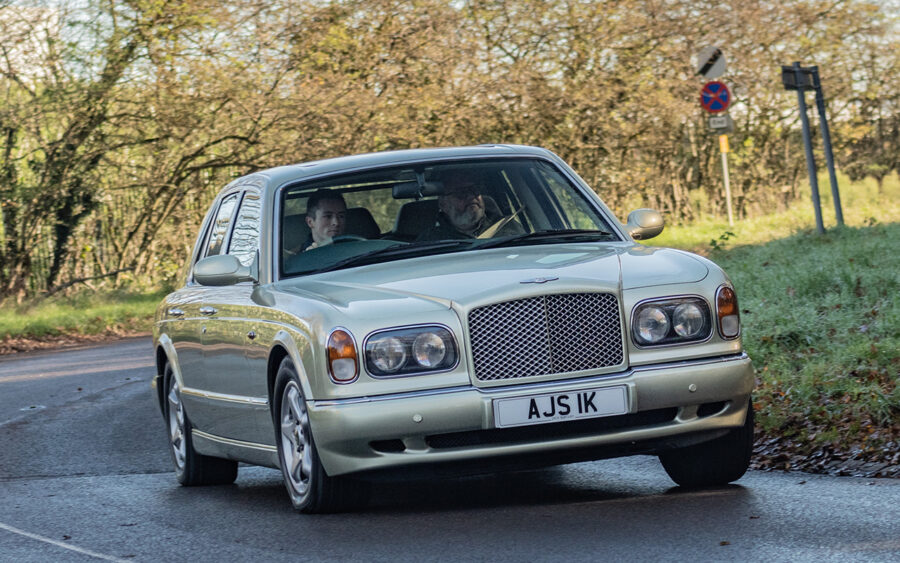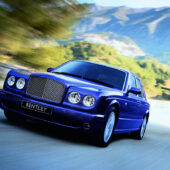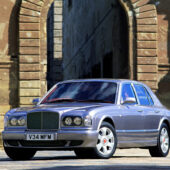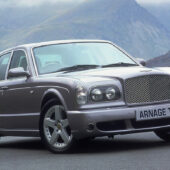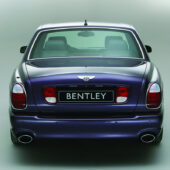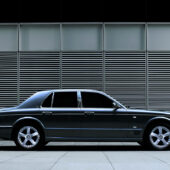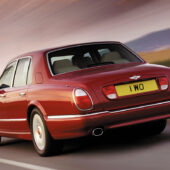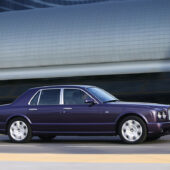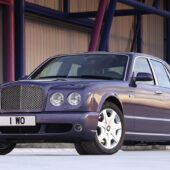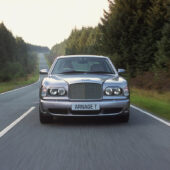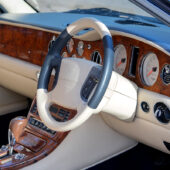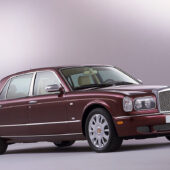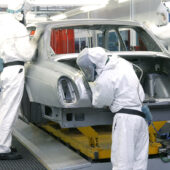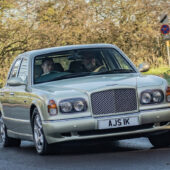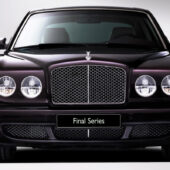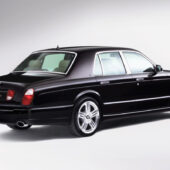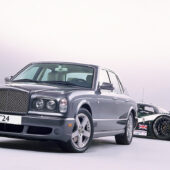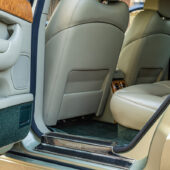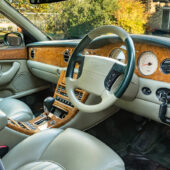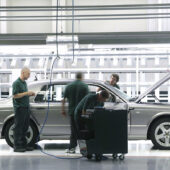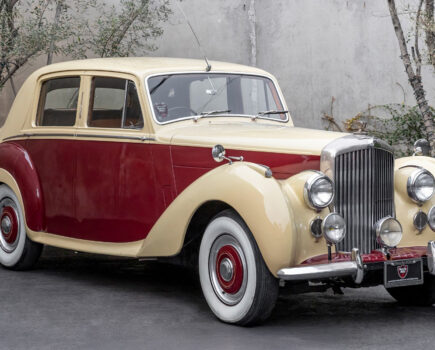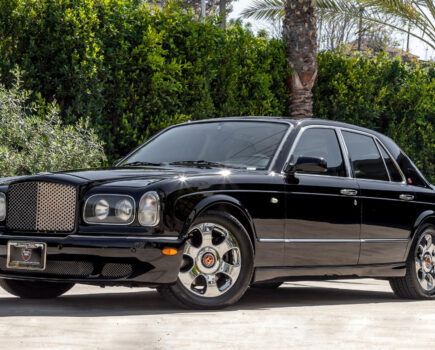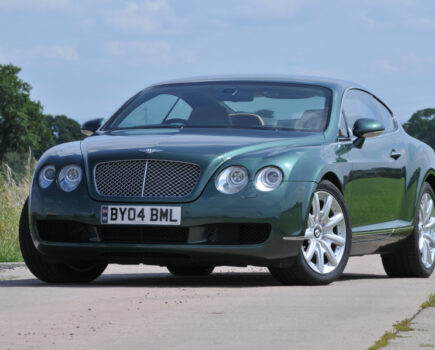The Bentley Arnage has a complex history as a car that survived a tumultuous battle for its manufacturer’s takeover. Here’s the lowdown
Words: Richard Gunn
As much as this is a history of the birth and evolution of the last Bentley to be designed during the 20th century, it’s also (inevitably) a look at the very public battle between Volkswagen and BMW for ownership of the Bentley and Rolls-Royce names. The car was launched in the middle of the takeover tussle between the two German giants. And when BMW snatched the rights to Rolls-Royce from under VW’s nose – and at a fraction of the price that VW had paid for Bentley – it would have quite radical repercussions for the new Arnage.
However, we’re getting ahead of ourselves, for the origins of the Arnage date back to the days when Vickers was in charge of both marques. The British aviation, defence, marine and engineering conglomerate had acquired Rolls-Royce and Bentley in 1980, and it was under Vickers’ watch that Bentley began to properly re-emerge from the shadow of its parent marque. Restoring a more sporting image to the Flying B, with turbocharged models that looked more than just slightly different to Rolls-Royces, meant that Bentleys rose from representing just 5% of production when Vickers rode in, to 40% by 1986. Five years later it was a 50:50 split between Rolls-Royce and Bentley, with the latter’s share still climbing.
Initial work on successors to the Silver Spirit and its various Bentley derivatives (from Mulsanne to Brooklands and Turbo RT) got under way in the late 1980s, with design officially commencing in October 1990 under engineering director Mike Dunne, chief designer Graham Hull and Steve Harper. Management was happy enough with the way things were going to ‘freeze’ the conceptual design in June 1991.
However, after Dunne retired in 1992, his role as project director passed to Tony Gott, a former TI and Lotus engineer. He took over in January 1994, and it was under him that several refinements were made before the definitive design was reached later that year. (Gott, incidentally, would ultimately end up as the overall boss of Rolls-Royce from 2002 to 2004.) In July of 1995, design patents were taken out for the Rolls-Royce Silver Seraph and Bentley Arnage, based on prototypes machines.
While the angular Spirit’s styling had clearly been an evolution of the previous Shadow, the Seraph was much more of a clean-sheet effort, with its body adopting some pleasing curves. Hull had been influenced by both the Silver Cloud and yacht styling for his creation. Aside from the radiator grille, badges and wheels, the Arnage was externally identical to its Rolls-Royce sister. On both cars, more complex electronics were incorporated as standard, including adaptive ride control, anti-lock brakes and digital engine management.
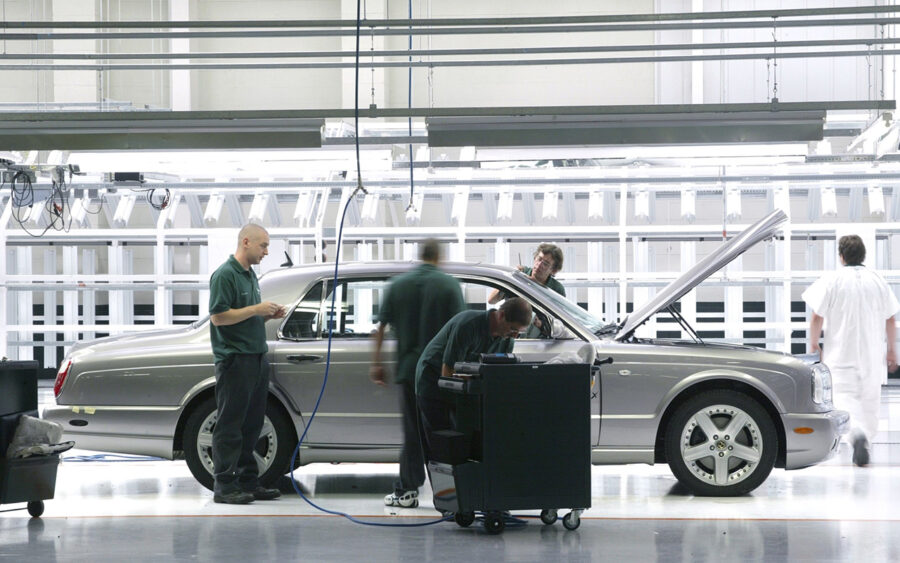
And it was the engine – or rather engines – that proved to be the real talking point. By the 1990s, it was felt that the trusty 6750cc L-series V8 was a little long in the tooth, having been the mainstay of all Rolls-Royces and Bentleys since 1959. There was a desire to come up with something a little fresher. However, Vickers at the time was going through one of its more turbulent financial periods, and there simply wasn’t the money to develop a new body and engine. The way forward had been signalled by the appearance of a concept Bentley – the Java – at the 1994 Geneva Motor Show, which used a BMW 5-Series platform. This partly prompted Vickers to take the controversial decision to buy in engines from another manufacturer – plus it would be making its own bodies rather than having them constructed by Pressed Steel, as previously.
Responsible for pressing the body panels was Vickers itself at its factory in Newcastle-on-Tyne, as well as the engineering contract group Mayflower, using its plant in Coventry. Rolls-Royce invested £40 million in a new body shop occupying the old engine assembly area at Crewe. Production of the V8 engines for the outgoing models shifted to Cosworth Engineering in Wellingborough, which Vickers had acquired in 1990.
But which engine supplier should Rolls-Royce go with, bearing in mind its constant need to win back the title of ‘The Best Car in the World’? A Ford V12 and General Motors’ Northstar V8 were both considered… but rejected. Ultimately, the choice came down to BMW or Mercedes-Benz. The latter seemed the best choice; it had on offer V8 and V12 engines that were simply better than the BMW equivalents. However, because BMW had previous connections with Vickers – the Bentley Java concept for starters, as well as a 1992 joint venture to design and develop medium-sized aircraft fan jets – it was Munich that triumphed over Stuttgart. The decision to team up with BMW was taken in December 1994. The German marque also offered to buy a 20% stake in Rolls-Royce, but this was rejected.
For the Rolls-Royce Silver Seraph, the M73 5379cc V12 was chosen, a unit also used in the E38-generation BMW 750. For the Bentley Arnage, however, it was the 4398cc M62 V8, with both engines being mated to five-speed automatic transmissions.
By late 1997, development work on the new Silver Seraph and Arnage was over and pilot production cars began to appear from early ’98, with both models making their debut at that year’s Geneva motor show. Perhaps inevitably, there was some discontent among traditionalists that two such resolutely British marques should now be powered by German engines, even though both the V8 and V12 offered improvements over the old unit. While both Seraph and Arnage were very similar inside and out, the Bentley had a centre gear selector and more comprehensive instrumentation laid out in a slightly different style. The Seraph had a column-mounted selector and fewer dials.
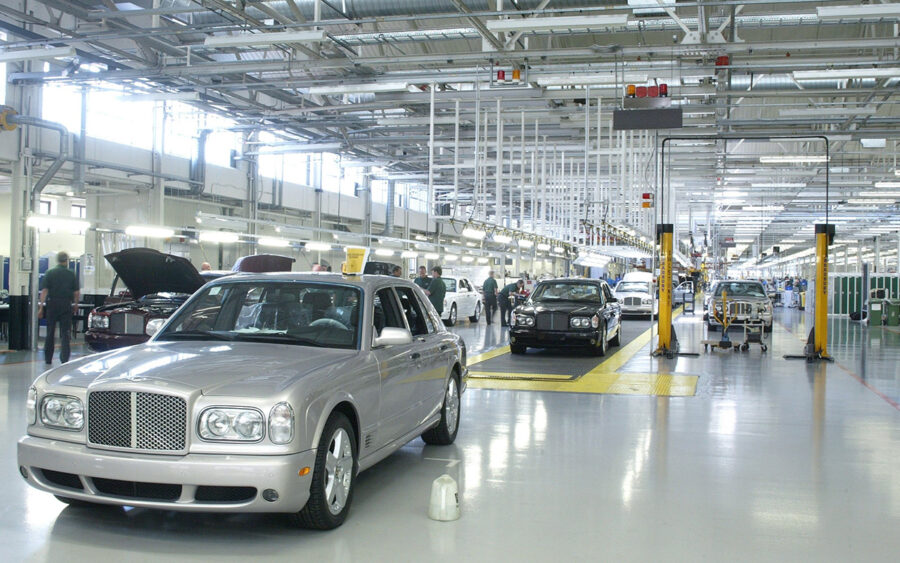
The Arnage and Silver Seraph weren’t the only things for sale that year, as Rolls-Royce and Bentley were also up for grabs, with Vickers having confirmed it intended to divest itself of its car division to focus more on its core businesses in October 1997. BMW, Mercedes-Benz, Volkswagen, Ford and Ferrari were all cited as interested parties, but eventually BMW emerged as the frontrunner. In April 1998, Vickers reached a formal agreement with BMW to sell Rolls-Royce to it for £340m. However, at the last minute VW nipped in with a £430m offer, which Vickers’ shareholders voted to accept in the July.
What Volkswagen got for its money was Bentley, the Crewe factory, and the rights to the Spirit of Ecstasy mascot and Rolls-Royce radiator shape. It didn’t, however, have the rights to the Rolls-Royce name, which was still controlled by the separate Rolls-Royce PLC aero engine company. It’s genuinely difficult to comprehend that VW didn’t do due diligence, and it later claimed it had only wanted Bentley anyway – by then the dominant marque. But the impression was that VW had slipped up, especially when BMW asked the PLC if it could use the Rolls-Royce name on cars, and was handed it on a plate for just £40m.
A major headache for Volkswagen was that the Arnage used a BMW engine – which BMW had threatened to stop supplying while the two were at loggerheads over ownership of Rolls-Royce and Bentley. Eventually, the two German giants did sort out their issues, but having to use such major components from BMW still didn’t sit well with VW, and it decided to re-engineer the Arnage to accept the old Rolls-Royce L-series V8 after all. The official line was that customers just weren’t keen on a BMW engine in a Bentley, despite sales of the German-powered cars being perfectly respectable.
To differentiate between the two versions, 2000-model-year cars with BMW engines were rebadged as Arnage Green Labels, while those with the newly reintroduced traditional British V8s (which were effectively the same single turbocharger units as used in the Turbo R) were dubbed Arnage Red Labels. Their debut came in October 1999, with both variants receiving a stiffer bodyshell and larger wheels and brakes, plus an Alpine pop-up navigation system, parking sensors, modified seats to improve their rear legroom, folding electric door mirrors, a modified steering rack and plastic headlamp covers in place of glass.
The final 52 BMW-powered Arnages were constructed during 2000 as Arnage Birkins, referencing one of the most prominent ‘Bentley Boys’ of the 1920s and ’30s, Tim Birkin. One of the differences was that, instead of five gauges in the centre of the dash, there were just three. These cars were sold into 2001, after which the BMW-powered Bentley was no more. The Red Label tag was now no longer needed for differentiation and was dropped in 2002, shortly after a long-wheelbase model – with an extra 250mm of length in its middle – had been unveiled.
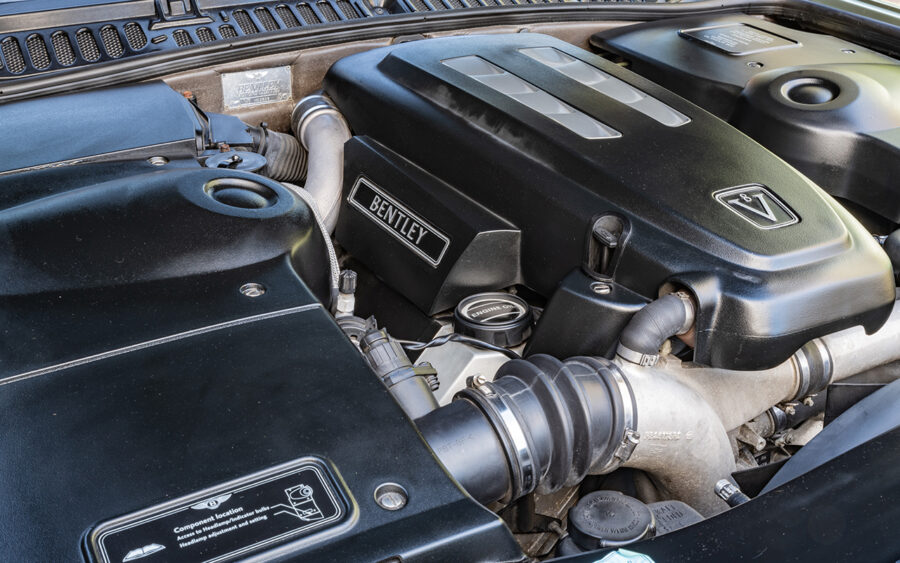
Alongside that was the normal-sized Arnage Le Mans Series, commemorating Bentley’s return to the Le Mans 24-hour race after 71 years. Just 153 of these appeared, with distinctive features such as quad exhaust pipes, front wing vents, five-spoke alloy wheels with red calipers visible through them, wider wheelarches, remodelled bumpers, dark racing green instruments with Le Mans lettering, drilled pedals, darker burr walnut veneer, and chrome and leather-clad gear levers. The exterior colours were Silver Storm, Black Oriole and Le Mans Racing Green.
Replacing the Red Label, meanwhile, were the Series Two Arnage R and Arnage T. Bentley claimed that the Series Two had been completely re-engineered, which was overstating things somewhat, but more stiffening was added and there were suspension upgrades as well. Under the bonnet, two smaller Garratt T3 turbochargers replaced the previous single T3 item. What wasn’t mentioned in the Series 2 publicity was that the engine was also slightly modified to try and reduce the number of head gasket failures that had been besmirching the Bentley image. Visually, new bumpers, tailpipes and side sills (plus a reduction in chrome) made the cars stand out from their predecessors. Inside, the seats were made more comfortable.
The R was the more laid-back of the Bentley bunch with ‘just’ 399bhp, the T being further tweaked to an impressive 450bhp to offer a top speed of 170mph and a 0-60mph time of just 5.5 seconds. At this point, the LWB model became the RL. Another very exclusive model of 2002 was the Bentley State Limousine, which was developed from the Arnage for the Queen’s Golden Jubilee; just two were built, and they remain in use for state duties today.
Bentley’s win at the 2003 Le Mans 24-hours led to a very limited run of forty special cars created by Mulliner. These T24 Bentleys shared similar features to the earlier Le Mans models, but also had Union Flag badges, 19-inch split-rim polished alloy wheels, and carbon fibre in place of the usual wood.
In 2005 came a further facelift, with different headlamps and bonnet line, new wheels, enhanced suspension and new switchgear – the latter doing away with anything from the BMW parts bin in favour of Volkswagen controls instead. A drophead coupé was shown off at the 2005 Los Angeles Auto Show but wouldn’t make it to production until 2007.
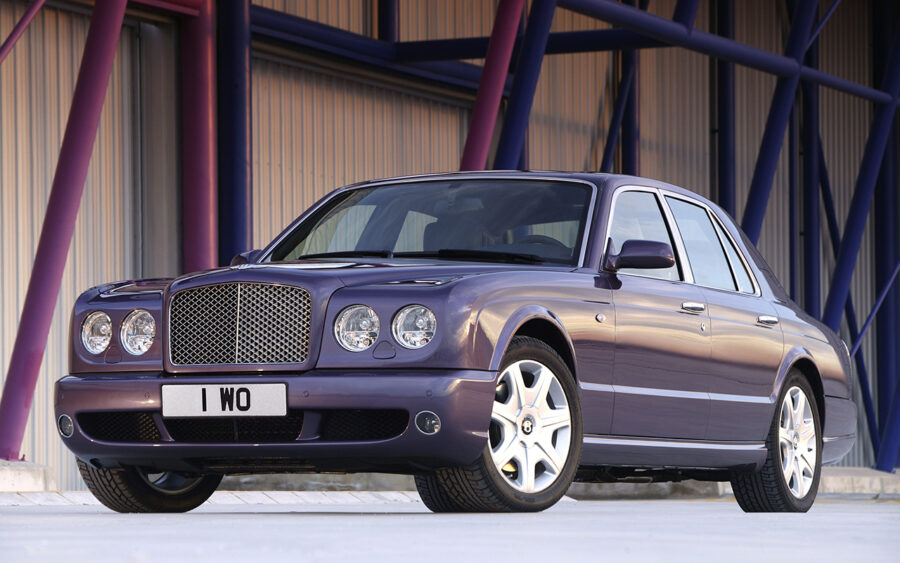
More limited editions followed, including 2005’s Arnage Blue Train to commemorate the 75th anniversary of Wolf Barnato’s famous race against the French Blue Train Express between Cannes and Calais. The 36 models were based on the Arnage R, but with the T’s 450bhp engine. Among the features were a dash-mounted plaque that had a silhouette of the Gurney Nutting coupé that was believed to have been Barnato’s car. It was only some years later that it was discovered that a Mulliner-bodied saloon had been used instead, thus meaning every Arnage Blue Train portrayed the wrong car.
Bentley’s sixty years of production at Crewe was marked by the Arnage Diamond Series, with sixty cars planned – although it seems the company fell one short. Diamond-quartered wood, diamond-quilted leather, a mesh front grille, stainless steel bumpers and 19-inch alloy wheels were standard fitment. But what enthusiasts probably appreciated most was the reappearance of a Flying B mascot topping off the radiator surround – the first time one had been used on a series production Bentley since the 1970s.
In 2007, there was another update, albeit with most of the changes being under the skin. The Arnage T saw power rise to 500bhp, which made 179mph possible, while the Arnage R’s output rose to 450bhp. It was the fitment of new Mitsubishi low-inertia turbochargers that helped make these surges in power possible; they spooled up to maximum speed in half the time of the previous Garratt units, although a reprofiled camshaft and revamped electronics also played their role. Remarkably, the 2007 version of the 6750cc V8 had around 300bhp more than its 1959 incarnation, yet only 60% of its fuel consumption.
Bentley announced in September 2008 that it would cease building the Arnage the following year, by which time it would have outlived Rolls-Royce’s Silver Seraph by seven years. The last 96 cars were dubbed the Final Series models and were really quite special indeed – so much so that they deserve a more in-depth examination, which you’ll find on page XX). The replacement for the long-running Arnage was to be the Mulsanne, marking the revival of a name from the days when both Bentley and Rolls-Royce were still married. However, for the first time in many decades, there would be no commonality with the marque that was now one of Bentley’s biggest rivals.

